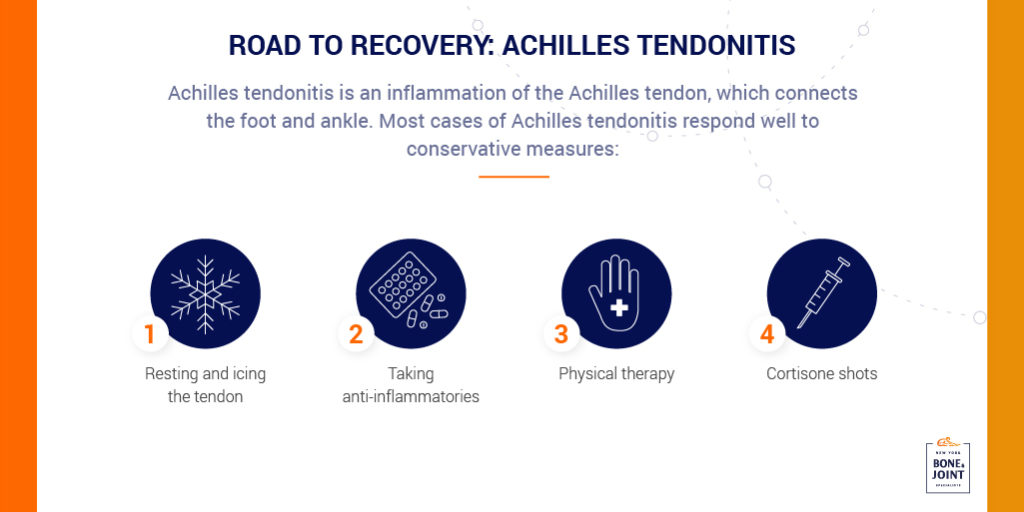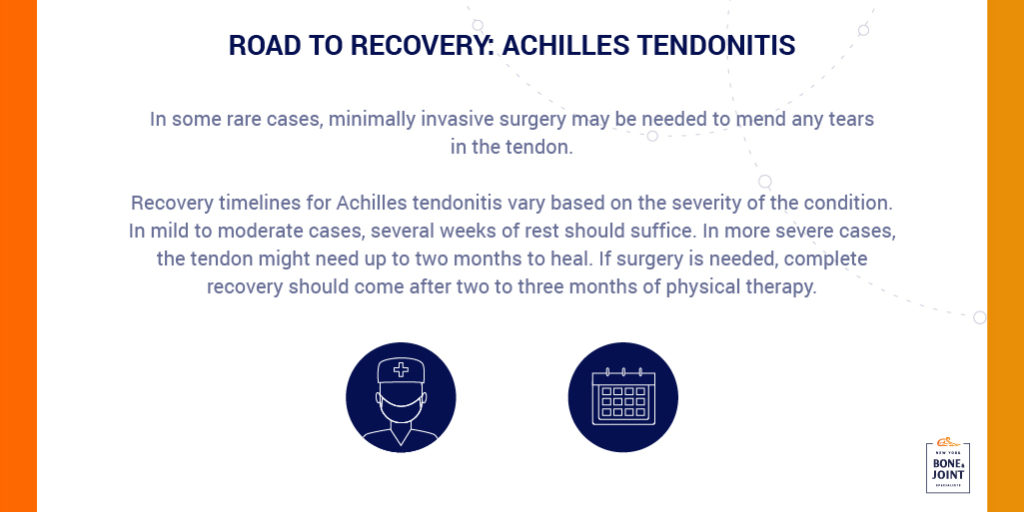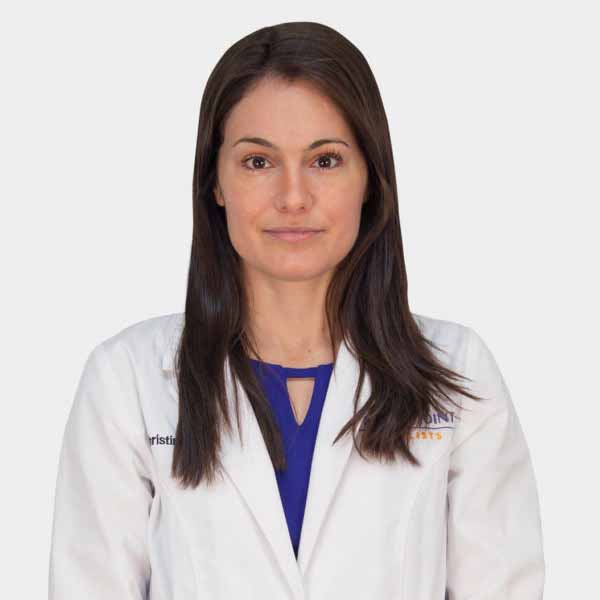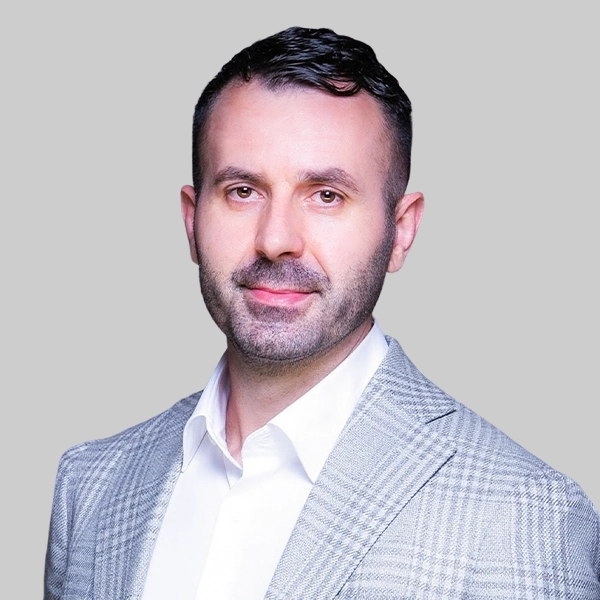Tendons are strong, thick bands of tissue that connect muscles to bones and enable joint movement. Because we use them constantly, tendons are prone to injury and strain.
One of the most common tendon injuries is Achilles tendonitis. The injury is common among athletes, but anyone can develop Achilles tendonitis if their tendon is stressed, degenerates, or is injured.
Achilles tendonitis can make everyday tasks like walking or climbing stairs difficult and painful. If you’re experiencing pain at the back of your ankle, you may need to see an Achilles tendon doctor. In New York, expert care is available from specialists at New York Bone & Joint Specialists.
Our highly trained orthopedists specialize in treating Achilles tendon injuries. We create customized treatment plans tailored to your needs, overall health, and the severity of your condition, starting with conservative therapy and recommending surgery only when necessary. We’re here to help you return to a pain-free life.
What Is Achilles Tendonitis?
The Achilles tendon connects the calf muscles to the heel bone. You use it when walking, running, climbing stairs, or rising onto your toes.
Like other tendons, it can become inflamed due to overuse, particularly in activities involving sudden starts, stops, and jumps, such as basketball. It’s commonly diagnosed in runners who rapidly increase their mileage or frequently run uphill. Trauma or degeneration can also lead to Achilles tendonitis.
Tendonitis vs. Tendinosis
Both are types of tendinopathy (tendon injury), but they differ:
- Tendonitis: Inflammation due to a sudden or acute injury, often from overuse, causing microtears in the tendon.
- Tendinosis: Chronic tendon degeneration from prolonged overuse without adequate healing. It’s often misdiagnosed as tendonitis.
Both conditions can severely limit simple movements, but conservative treatments led by a specialist can promote recovery.
Types of Achilles Tendon Problems
- Achilles tendonitis: Inflammation caused by overuse or a sudden stretch.
- Achilles tendinosis: Long-term tendon degeneration, often due to aging and repeated stress.
- Achilles tendon rupture: A partial or complete tear that may require surgery, especially for athletes.
Location-Based Types:
- Noninsertional Achilles tendonitis: Affects the middle portion of the tendon. Common among active individuals.
- Insertional Achilles tendonitis: Affects the lower portion near the heel bone. It can impact anyone, but it often affects overuse-prone individuals.
Causes and Risk Factors of Achilles Tendon Injuries
Achilles tendon injuries can strike anyone for a variety of reasons, but it’s most likely due to:
- Aging: Natural tendon degeneration over time.
- Athletic activities: Sports with frequent ankle motion, such as running, soccer, and dancing.
- Infrequent exercise: Weekend-only or sporadic activity increases injury risk.
- Sudden activity changes: Quickly ramping up duration or intensity can overload the tendon.
- Improper footwear: Shoes lacking heel or arch support.
- Biomechanical issues: Flat feet or overpronation increase strain.
- Previous injuries: Recurrent stress to an already weakened tendon.
- Bone spurs: Friction from heel bone growths can cause inflammation.
“Your Achilles tendon is your body’s strongest tendon, but when it’s injured, every step becomes a reminder of the pain. Our evidence-based treatment protocols combine rest, therapy, and advanced healing techniques to get you back to running and jumping pain-free.” – Dr. Leon Popovitz, MD, Co-Founder of New York Bone & Joint.
Symptoms and When to See an Achilles Tendon Doctor
Achilles tendonitis can begin as a mild pain in the heel area. But without treatment, it can progress with more noticeable symptoms:
- A burning pain at the back of the foot
- Stiffness and swelling in the tendon
- Inability to flex the foot or ankle without pain
- Heel pain when stretching the calf
When should I see an Achilles tendon specialist?
Achilles tendonitis can resolve with at-home treatments, such as taking pain relievers and resting for a few days. But consult with an Achilles tendon specialist if:
- Pain lasts more than a few weeks
- Symptoms worsen
- You suspect a rupture (often accompanied by a popping sound)
Our Diagnosis Process
At New York Bone & Joint Specialists, we follow a step-by-step approach to diagnosing Achilles tendonitis.
Physical examination. The doctor will assess your range of motion, swelling, and pain points.
Imaging studies. An X-ray cannot see the soft tissue, but can uncover a bone spur causing the pain. An MRI or ultrasound provides a better picture of the damaged tendon. The images can also show if the tendon is inflamed, partially torn, or completely ruptured.
If the tendon is ruptured, the tear will be classified as:
- Grade 1: Minimal torn tendon fibers, or a partially torn Achilles.
- Grade 2: Less than half the Achilles tendon fibers are torn,
- Grade 3: A full rupture when the majority or all the fibers tear.
Comprehensive Treatment Options
Achilles tendonitis responds very well to conservative therapies, stretching and strengthening the muscles around the tendon.
Conservative Treatments:
Activity modification. Avoid activities that cause pain in the heel area. You can follow the RICE method to reduce pain and swelling when the tendonitis begins:
- Rest. Stop doing any exercise that stresses the Achilles tendon. You can do low-impact activities such as swimming and biking.
- Ice: Place a cold compress on the affected tendon for 20 minutes periodically during the day to bring down swelling.
- Compression. Wrap the ankle in an ACE bandage.
- Elevation. Raise your foot above your heart to rush blood to the ankle and stimulate healing.
Physical therapy. Do exercises designed to strengthen and improve flexibility in the tendons. As the Achilles tendon heals, you can add weight-bearing exercises to your routine.
Achilles tendon stretches. The best stretching exercises engage the heel and calf muscles.
Best shoes for Achilles tendonitis. Purchase shoes with good arch support. The back should “hug” and cushion the heel. Sandals and walking barefoot are not recommended.
Orthotics and heel lifts. Inserts that lift the heel can relieve tendon pain and tension in the tendon. You can buy one commercially or get a prescription for a tailor-made orthotic.
Anti-inflammatory treatments. Over-the-counter anti-inflammatories such can reduce pain and inflammation.

Advanced Therapies:
In addition to conservative therapies, newer non-invasive treatments can help heal a damaged Achilles tendon.
PRP injections. Platelet-rich plasma therapy uses the blood of the patient to spur healing. After drawing blood from the patient, the doctor puts the blood into a machine that separates out the platelet cells. The resulting solution contains growth factors to mend the damaged tendon.
Shockwave therapy. In a 30-minute session, shock waves are pulsed into the injured tendon to promote healing. You may experience minor side effects such as bruising, pain, and numbness in the area.
Dry needling. Dry needling has proven effective in addressing the pain of Achilles tendonitis. In this procedure, the area is cleaned with an antiseptic. Using an ultrasound to view the precise location of the tendon, our Achilles tendon specialists repeatedly pass the needle through the injured tendon to encourage small bleeds, which in turn pushes through nutrient-filled blood to mend the damaged area.
Custom rehabilitation programs. Every patient is different. At New York Bone & Joint Specialists, our doctors will tailor a customized rehabilitation program based on your health status and activity level to ensure you can do everyday tasks and play sports with a stronger Achilles tendon after the therapy.
Surgical Options:
Surgery may be an option if the tendon ruptures. Athletes with a torn Achilles tendon benefit the most from surgery to repair the damage. Surgery may also be done if conservative methods fail.
Minimally invasive techniques
Percutaneous Achilles repair. The surgeon makes a series of small incisions along the back of the calf to access the tendon. Using small instruments, the damaged portion of the tendon is removed. If the tendon is completely severed, the surgeon sutures the ends together. Another option is to attach the tendon to the heel bone with sutures and small plastic screws drilled into the bone. Using smaller incisions shortens the healing time.
Tendon transfer. Reserved for extensive damage or a completely ruptured tendon. The surgeon will reposition the tendon responsible for flexing the big toe and anchor it to the heel bone with plastic screws. There is no loss of foot function because other muscles can move the big toe.
Gastrocnemius recession surgery. If the calf muscle is extremely tight, the surgeon lengthens one of the two muscles in the calf. This procedure can help people who have difficulty flexing their feet, even after months of calf stretches in a physical therapy program.
Surgical procedures are typically done on an outpatient basis and can last 30 to 60 minutes. After the operation, you’ll participate in a physical therapy program. Full recovery may take nine months to a year.

Achilles Tendon Exercises and Stretches
Physical therapy for Achilles tendonitis typically involves strengthening the calf muscles and boosting range of motion in the ankle. Always check with your doctor and physical therapist before starting an exercise program.
Eccentric strengthening protocols. These types of exercises use movements to lengthen the muscle. In the case of Achilles tendonitis, the target area would be the calf muscle. Examples include squats.
Progressive loading routines. Part of an Achilles tendonitis physical therapy program includes progressive loading exercises as your tendon heals. Under the guidance of a physical therapist, the patient uses a weight to boost calf muscle strength. For example, the patient may do a calf raise with a weight. The weight is gradually increased as the calf becomes stronger and the patient can tolerate the added pounds.
Stretching routines. Tight calf muscles raise the risk of Achilles tendonitis or a tear. Ask your physical therapist for exercises aimed at stretching the calf muscles.
Return to activity guidelines. A four- to six-week physical therapy program is the typical timeline for recovery from Achilles tendonitis. After that time, your doctor will review your progress and may recommend additional therapy. For a ruptured Achilles tendon, rehabilitation could take up to six months. After that, you may return to low-impact activities, such as walking and hiking. Athletes can expect to return to their sport after nine months.
Home exercise instruction. Many of the strengthening and stretching exercises can be done at home. But always consult with your physical therapist on the proper and safe way to workout. The physical therapist will also consider your daily activities and how you can perform them without causing tendon pain. The physical therapist can also give you a timeline for when you can return to more strenuous activities. If you experience significant pain, stop and consult with your doctor and physical therapist. Your exercise regimen may need to be modified.
Why Choose New York Bone and Joint Specialists as your Achilles Tendonitis doctors
New York Bone and Joint Specialists are counted among New York’s best foot and ankle doctors and surgeons. For decades, patients have trusted our expertise in convenient locations around New York City. Here’s why:
- We prioritize the health and healing of your tendons and muscles, essential for a long and active life.
- Our world-class joint specialists offer comprehensive and caring guidance, from diagnosis to full recovery, for a wide range of conditions.
- In over 90% of cases, our orthopedic treatments successfully resolve issues without the need for surgery.
- Our doctors are on the cutting edge of advanced treatment options for Achilles tendonitis therapies, including PRP injections.
- We are committed to complete patient recovery through conservative methods and expert surgical care when necessary.
- We accept a wide variety of insurance plans, and we work with your patients on payment plans that fit into their budget.
Our top-rated Achilles tendon specialists in NYC
At New York Bone & Joint Specialists, our top priority is the well-being of our patients. Our team of highly skilled physicians, surgeons, physical therapists, and support staff collaborates to deliver outstanding care and peace of mind. We focus on the sustained health and effective management of both chronic and acute Achilles tendon injuries.
Our in-house Achilles tendon experts, who are nationally recognized for their extensive accreditations, publications, and knowledge, are readily available for consultations.
Make an appointment today
Start your recovery today. Book your appointment with New York Bone & Joint Specialists now.
Achilles Tendon Injuries: FAQs
How long does Achilles tendonitis take to heal?
Conservative therapy for Achilles tendonitis can take as little as four months. Surgical repair may require a year-long recovery period at the high end. Whatever the treatment, stick to your physical therapy routine for the best chance of a full recovery.
What are the best Achilles tendon exercises?
Exercises to strengthen and stretch the calf muscles can reduce pain and improve mobility. Those would include progressive loading exercises and calf stretches.
Do I need to see an Achilles tendon specialist?
An Achilles tendon specialist gives you the best chance of a full recovery by combining physical therapy and other non-invasive treatments. Fortunately, the staff at New York Bone & Joint Specialists boasts orthopedists who specialize in foot and ankle problems.
What shoes should I wear for Achilles tendonitis?
Throw out your worn shoes and sandals. Buy shoes that cushion and protect the heel and have a firm arch to support the tendon. You can also buy or get a prescription for orthotics that lift the heel and relieve pressure on a tense tendon.
How can I prevent Achilles tendon injuries?
To prevent Achilles tendon injuries, you can:
- Stretch daily
- Strengthen the calf muscles
- Increase activity level gradually
- Cross-train by mixing in low-impact activities (swimming and biking) with high-impact exercises, such as running and jumping.











